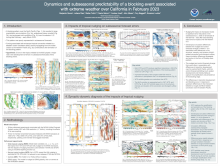Dynamics and subseasonal predictability of a blocking event associated with extreme weather over California during February 2023
Benjamin
Moore
NOAA Physical Sciences Laboratory
Poster
This study investigates the multiscale dynamics and subseasonal predictability of a blocking event associated with an extended period (~2 weeks) of anomalously cold conditions and extreme precipitation over southern California during February 2023. A reanalysis-based diagnosis reveals that a quasi-stationary blocking pattern was established and maintained over the eastern North Pacific in conjunction with repeated episodes of synoptic-scale baroclinic development and ridge amplification. Upper-level troughs and cut-off lows repeatedly formed on the downstream flank of the blocking ridge and propagated across the western U.S., resulting in successive episodes of heavy precipitation and cold-air advection over southern California.
During the two weeks leading up to the blocking event, an active Madden-Julian Oscillation (MJO) propagated from the Indian Ocean into the western tropical Pacific and contributed to the blocking formation. Subseasonal numerical model forecasts poorly represented this MJO and generally failed to produce the subsequent blocking. The link between forecast errors in the tropics, particularly those related to the MJO, and subsequent errors in the extratropical flow for this event are investigated through model experiments conducted with the NOAA Unified Forecast System. These experiments consist of two 30-member ensemble forecasts initialized ~2 weeks prior to the blocking onset: a “nudged” forecast, in which state variables within the tropics (20°S – 20°N) are nudged to the ERA5 reanalysis, and a control “free” forecast without nudging. Additionally, the two forecasts are run with and without air-sea coupling in the model, with sea surface temperatures damped to climatology in the uncoupled forecasts. Results reveal that a “perfect” representation of the tropics in the nudged forecasts yields marked improvements in the weeks 3–4 forecast of the extratropical flow pattern over the North Pacific and the concomitant extreme weather over California. The nudged forecasts with and without air–sea coupling successfully capture the formation and persistence of blocking. The free forecast without air–sea coupling fails to capture the propagation of the MJO and the blocking formation. The free forecast with coupling exhibits improved representation of the MJO and the extratropical flow response but underpredicts the amplitude and persistence of the blocking pattern. Processes contributing to the different outcomes in the nudged and free forecasts are examined and discussed.
During the two weeks leading up to the blocking event, an active Madden-Julian Oscillation (MJO) propagated from the Indian Ocean into the western tropical Pacific and contributed to the blocking formation. Subseasonal numerical model forecasts poorly represented this MJO and generally failed to produce the subsequent blocking. The link between forecast errors in the tropics, particularly those related to the MJO, and subsequent errors in the extratropical flow for this event are investigated through model experiments conducted with the NOAA Unified Forecast System. These experiments consist of two 30-member ensemble forecasts initialized ~2 weeks prior to the blocking onset: a “nudged” forecast, in which state variables within the tropics (20°S – 20°N) are nudged to the ERA5 reanalysis, and a control “free” forecast without nudging. Additionally, the two forecasts are run with and without air-sea coupling in the model, with sea surface temperatures damped to climatology in the uncoupled forecasts. Results reveal that a “perfect” representation of the tropics in the nudged forecasts yields marked improvements in the weeks 3–4 forecast of the extratropical flow pattern over the North Pacific and the concomitant extreme weather over California. The nudged forecasts with and without air–sea coupling successfully capture the formation and persistence of blocking. The free forecast without air–sea coupling fails to capture the propagation of the MJO and the blocking formation. The free forecast with coupling exhibits improved representation of the MJO and the extratropical flow response but underpredicts the amplitude and persistence of the blocking pattern. Processes contributing to the different outcomes in the nudged and free forecasts are examined and discussed.

Poster file
Moore_Benjamin_blocking_poster.pdf
(14.06 MB)
Meeting homepage
